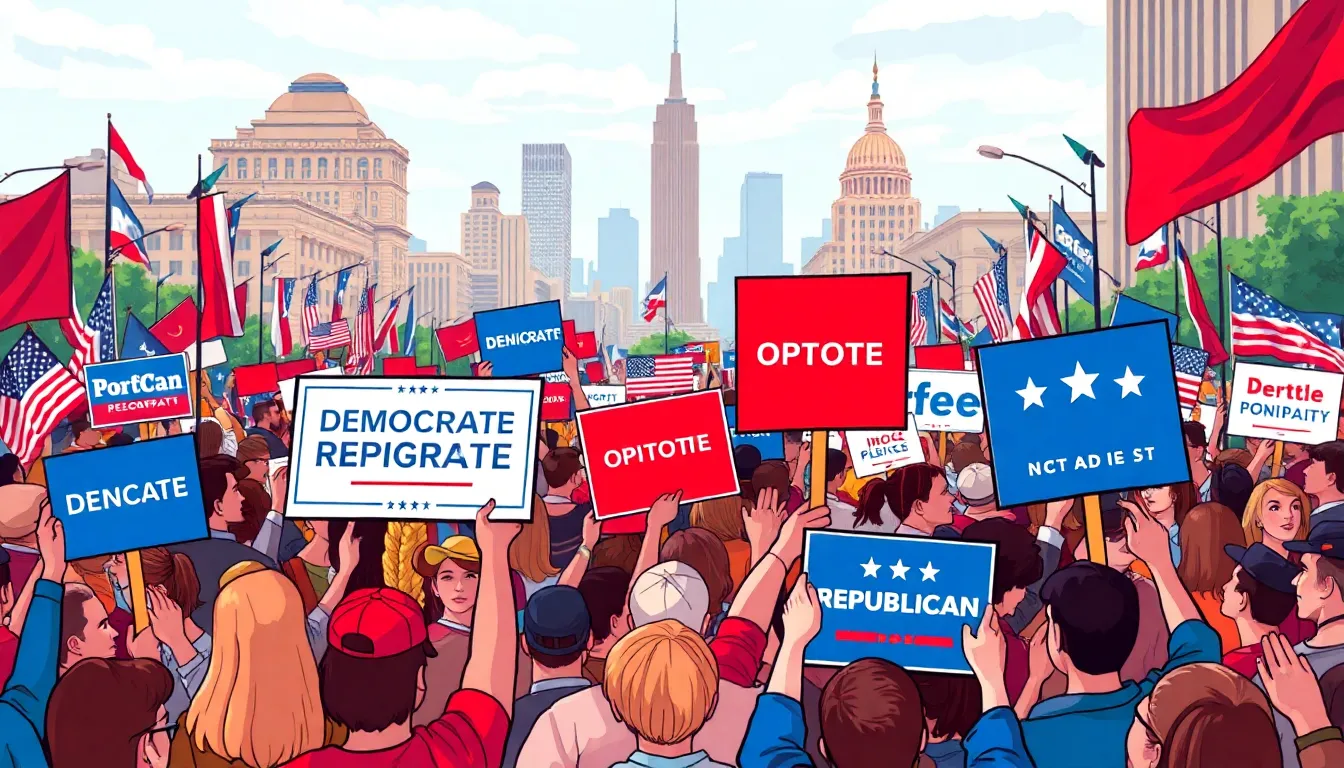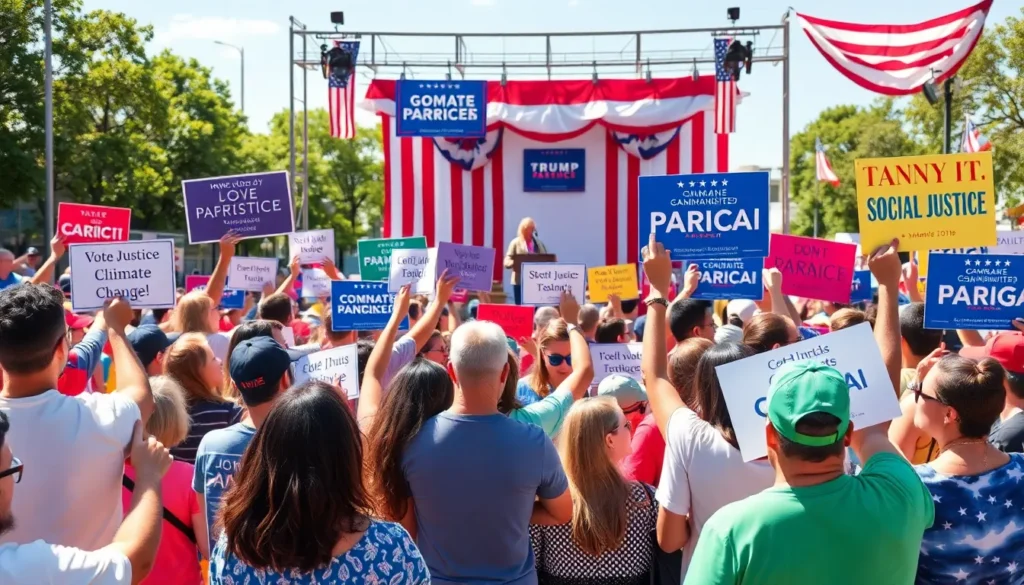Political campaigns in the United States can feel like a high-stakes game of Monopoly, where everyone’s trying to buy Park Place but ends up landing on Go instead. With candidates hustling for votes and parties battling for supremacy, it’s a wild ride filled with promises, debates, and the occasional viral meme. But what’s really true about this chaotic landscape?
Understanding the nuances of party politics can be as confusing as deciphering a toddler’s crayon drawing. Yet, it’s crucial to grasp the dynamics at play. Whether it’s the influence of social media or the power of grassroots movements, the truth behind these campaigns reveals much about American democracy and its ever-evolving nature. Buckle up as we dive into the fascinating world of political campaigns and uncover what really drives this electoral circus.
Table of Contents
ToggleOverview of Political Campaigns in the United States
Political campaigns in the United States display a dynamic and complex landscape, significantly influenced by historical shifts and contemporary trends. Understanding these factors reveals essential insights into the electoral process.
Historical Context
Political campaigns evolved dramatically since the founding of the United States. Early elections relied heavily on local gatherings and word-of-mouth communication. By the mid-20th century, media, particularly television, transformed campaigning strategies. Candidates began utilizing advertisements to reach broader audiences effectively. The emergence of the internet in the late 20th century further shifted dynamics, introducing online fundraising and social media engagement. These changes influenced voters and allowed for innovative outreach methods. The evolution of campaign finance laws also significantly impacted how campaigns operate.
Key Characteristics
Campaigns in the U.S. showcase several defining features. Emphasis lies on candidate personality and public perception, often influencing voter decisions. A focus exists on strategic messaging designed to resonate emotionally with specific demographics. Debates serve as critical platforms for presenting policies and contrasting with opponents. Grassroots movements play an essential role, empowering citizens to rally support around candidates. Additionally, the impact of digital platforms has injected speed and immediacy into campaigning. Overall, understanding these characteristics uncovers the multi-faceted nature of U.S. political campaigns.
Major Political Parties

The United States has two dominant political parties that shape its political landscape: the Democratic Party and the Republican Party. Each party plays a crucial role in national elections and influences policies across various issues.
Democratic Party
The Democratic Party emphasizes social equality and government intervention in the economy. Founded in the early 19th century, it supports progressive taxation, healthcare reform, and environmental regulations. Key constituencies include urban voters, minorities, and young people. Recent trends show an increasing focus on climate change and social justice initiatives. Their primary platform often prioritizes expanded access to education and healthcare, advocating for policies that aim to reduce economic disparities.
Republican Party
The Republican Party promotes individual freedoms and free-market principles. Established in 1854, it advocates for lower taxes, limited government, and states’ rights. This party traditionally attracts rural voters, business owners, and conservative Christians. Recent shifts highlight a renewed emphasis on national security and immigration control, responding to concerns about global challenges. Policies typically aim to boost economic growth through deregulation and support for small businesses.
Role of Campaign Strategies
Effective campaign strategies play a crucial role in shaping political outcomes in the United States. Candidates leverage various approaches to connect with voters and convey their messages.
Fundraising Techniques
Fundraising techniques are essential for campaign success. Candidates utilize online platforms to reach potential donors, making contributions quick and accessible. Events, such as fundraising dinners and rallies, also attract large sums of money. Direct mail campaigns and phone banking serve as traditional but effective methods for engaging supporters. Additionally, harnessing social networks helps amplify fundraising efforts, tapping into the enthusiasm of grassroots supporters. In 2020, the Democratic Party raised approximately $1.5 billion compared to the Republican Party’s $1.1 billion, illustrating the impact of strategic fundraising and mobilizing resources.
Media Influence
Media influence significantly impacts political campaigns. Television advertising remains a primary tool for candidates to convey their messages widely, reaching diverse audiences across the country. Social media platforms, including Twitter and Facebook, have transformed campaign strategies by enabling immediate communication with followers. Engaging content, such as videos and memes, can go viral, enhancing visibility and voter engagement. News cycles frequently shape public perception, affecting candidates based on coverage and commentary. In the 2020 election, candidates faced scrutiny over their social media use, emphasizing the necessity of managing their online presence to maintain control over their narratives.
Voter Engagement and Participation
Political campaigns in the United States emphasize voter engagement and participation as crucial components of the democratic process. Recognizing these elements offers insight into voter behavior patterns and campaign effectiveness.
Turnout Trends
Turnout trends reveal significant fluctuations depending on various elections. For example, the 2020 presidential election saw approximately 159 million Americans cast their votes, equating to 66.7% of the eligible voting population. Engagement strategies such as mail-in voting and early voting contributed to this rise. Compared to previous elections, turnout in 2016 was only about 60.1%. Non-presidential elections also witness varying participation rates, with midterms typically resulting in lower engagement, such as the 2018 midterm elections which recorded a turnout of 50%. These patterns underscore the importance of effective outreach by candidates to boost participation.
Demographics of Voters
Demographic factors significantly influence voting behavior across the United States. Age plays a critical role; younger voters, aged 18 to 29, participated at a 50% rate in the 2020 election, an increase from 36% in 2016. Additionally, racial and ethnic backgrounds affect turnout, with approximately 60% of Black voters and 53% of Hispanic voters participating in 2020. Educational attainment also impacts engagement, as individuals with a college degree tend to vote at higher rates compared to those without. Understanding these demographics assists campaigns in tailoring their messages to resonate with specific voter groups, ultimately driving higher engagement.
Challenges in Political Campaigns
Political campaigns in the United States face significant challenges that impact their effectiveness and public perception.
Misinformation and Media Bias
Misinformation poses a critical challenge in political campaigns. Candidates often combat false narratives that spread rapidly on social media. Data shows that 53% of voters encountered misleading information during the 2020 election cycle. Media bias complicates matters further, as various outlets demonstrate leanings that shape narratives favorably or unfavorably for candidates. Research indicates that 62% of Americans express concern regarding biased news coverage. Campaigns struggle to counteract these influences while seeking to maintain credibility and public trust.
Partisan Polarization
Partisan polarization creates a divided electorate that complicates campaign strategies. Candidates encounter heightened emotional attachments to party identities, with surveys showing that 47% of Americans prioritize party loyalty over candidate qualifications. This divisive atmosphere produces significant challenges for cross-party dialogue and compromises that could bolster voter turnout. As political affiliations intensify, campaigns must navigate this polarization to appeal to independent and moderate voters. Strategies that promote unity or focus on shared concerns often resonate better in such a fractious environment.
Political campaigns and party politics in the United States are intricate and ever-evolving. The interplay of candidate strategies, media influence, and grassroots movements shapes the electoral landscape. As voter engagement continues to rise and demographics shift, understanding these dynamics becomes essential for grasping the future of American democracy. The challenges of misinformation and polarization further complicate the process, highlighting the need for candidates to adapt their approaches. By navigating these complexities, political actors can foster a more informed and engaged electorate, ultimately strengthening the democratic process.





